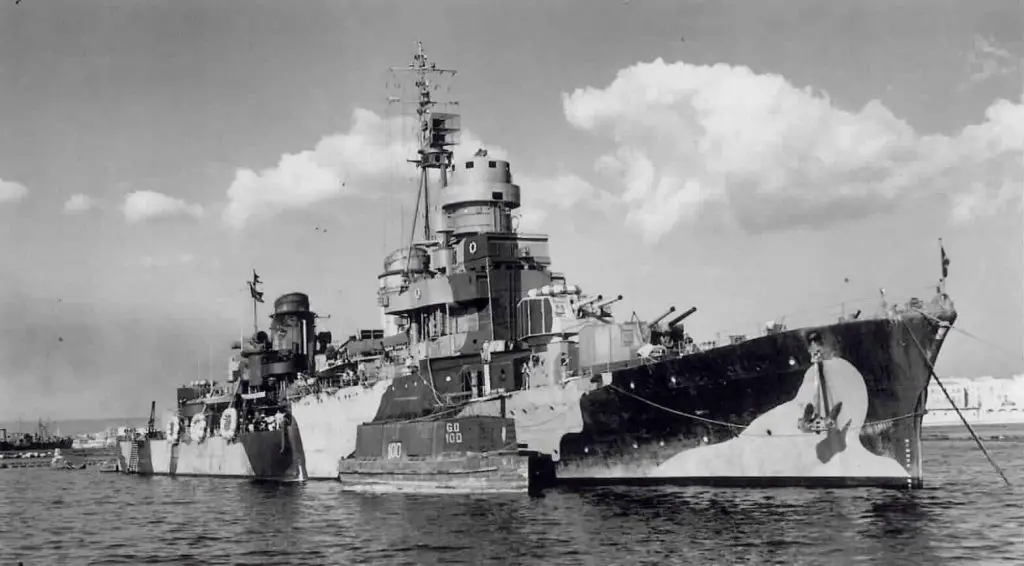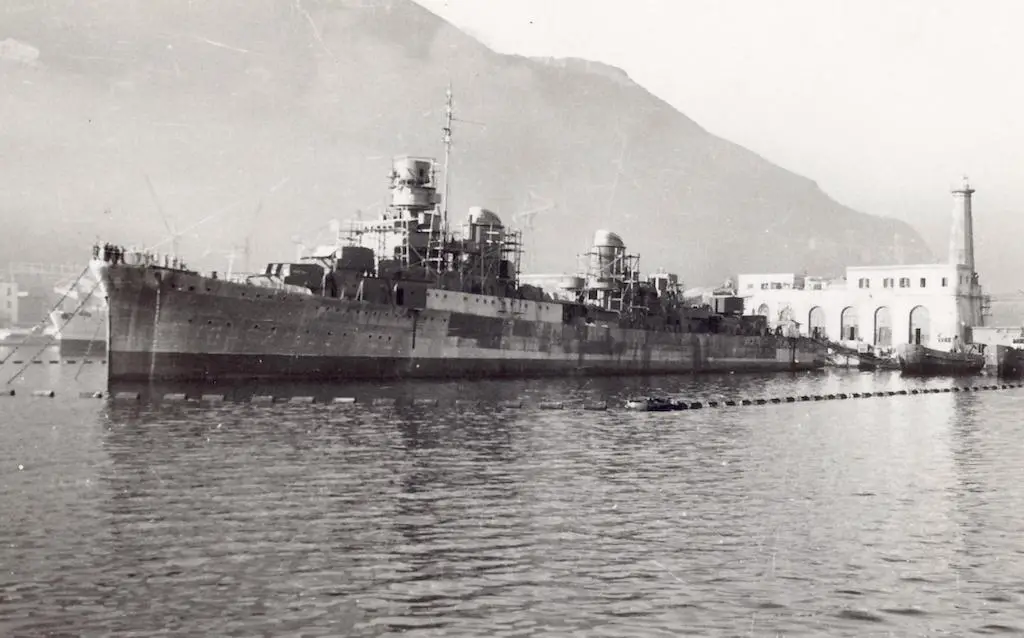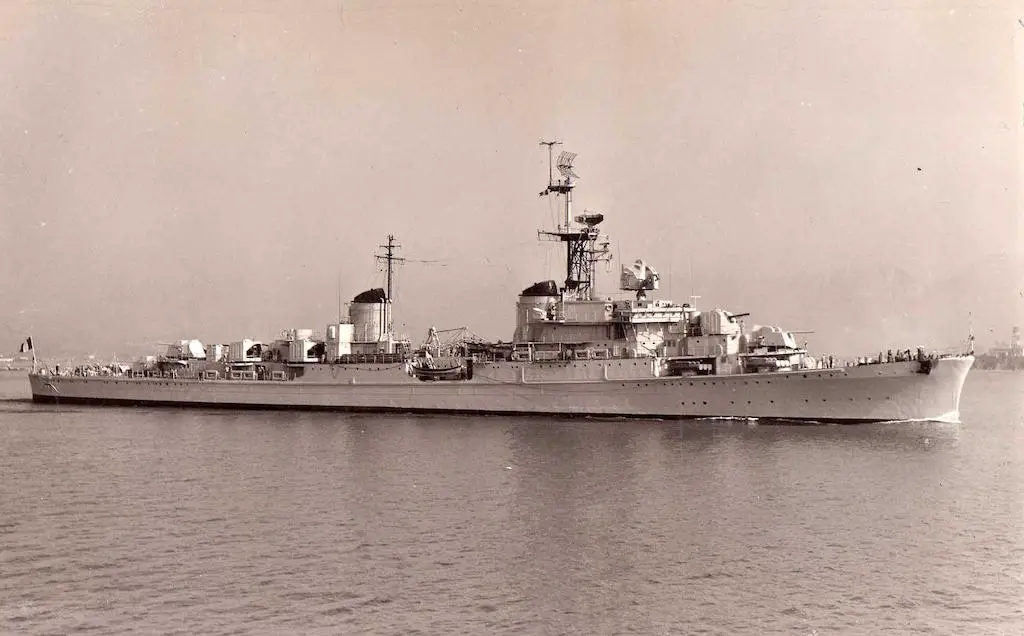Origin of the Capitani Romani Class
The development of the Capitani Romani class has its origin in the 1920s. New naval constructions of the Regia Marina depended on what the French Marine Nationale developed and launched. This is because France was believed to be the main rival and possible opponent in the Mediterranean waters.

Scipione Africano in October 1943.
The most notable examples were the Giussano Class Cruisers being a direct response to the La Fantasque class destroyers and the Littorio Class battleships being a direct response to the Dunkerque class battlecruisers.
Threat of Fast French Destroyers
In 1938 the appearance of the Mogador Class destroyers sounded the alarm among the ranks of the Regia Marina. These units were larger (3500 tons) and better armed (8x138mm guns) than any Italian destroyers. But, most notably, they were incredibly fast, able to reach 40-41 knots.
There were no units in the Regia Marina able to reach this high speed and at the same time able to deal with the Mogador class destroyers. To counter this threat, the Navy instructed General Umberto Pugliese (designer of the Littorio class battleships and of the “Pugliese” torpedo defense system) and Ignazio Alfano to design a large destroyer capable of outclassing the Mogador. The two skillful engineers accepted the task and started their work from the design of the Taskent, a flotilla leader built in Italy for the Soviet Union and launched in 1937.
Armor
The project involved a difficult task; providing a ship displacing 3500 tons, armed with eight guns and able to reach 41+ knots. Planners immediately ditched the idea to equip the ship with a seaplane. The vessels had limited armor protection. Only 20mm in the frontal plates for the gun turrets and 6mm above. The command tower had anti-splinters protection.
For the first time, construction included new and lighter steel alloys. Such features helped designers to meet their goals and, at the same time, grant a certain level of robustness to the vessels due to the weak armor protection.
Armament
The main armament comprised of 4 twin turrets mounting the excellent 135mm/45 OTO 1937 gun which had a reduced muzzle velocity to the benefit of precision. The same type of guns formed the secondary armament (in triple turrets) of the reconstructed Duilio Class Battleships.
The original AA armament was meant to rely on the new upcoming single 65mm/64 OTO 1939 not yet available when Pugliese and Alfano were designing the ship. However, weapon development took more time than planned. In fact, delivery of the first guns only happened in March 1943. So the choice fell on the classic Breda 37mm/54 and Scotti-Isotta-Fraschini 20mm/70 autocannons. To complete the ship’s armament, 8x533mm torpedo tubes in a two-quadruple mounting which could fire on both sides.
Propulsion
Finally, the ship propulsion relied on two geared turbines and four boilers generating 110.000 shp. The vessel showcased a power superior to any Condottieri-type Cruiser and even Zara Class heavy cruisers.
Construction
| Ship | Builder | Laid Down | Launched | Completed |
|---|---|---|---|---|
| Attilio Regolo | OTO Livorno | 28 September 1939 | 28 August 1940 | 15 May 1942 |
| Giulio Germanico | Navalmeccanica, Castellammare di Stabia | 3 April 1939 | 26 July 1941 | 1956 as San Marco |
| Pompeo Magno | CNR Ancona | 23 September 1939 | 24 August 1941 | 24 June 1943 |
| Scipione Africano | OTO Livorno | 28 September 1939 | 12 January 1941 | 23 April 1943 |
As the project finalized, 12 ships of the class were ordered and laid down by the end of 1939. Named as the“Capitani Romani” class, the vessels took the names of famous leaders and generals of ancient Rome.
They were initially classified as Ocean-going destroyers but shortly after were re-classified as Flotilla leaders, some sources also describe them as light cruisers.
The outbreak of the war and the shortage of raw materials greatly affected the construction of the Capitani Romani. The Regia Marina also prioritized the construction of smaller units like the Soldati class destroyers (second series) and the Gabbiano corvettes, urgently required for the escort duties in the Convoy war.

Capitani Romani Class cruiser Giulio Germanico in Castellammare di Stabia, 1943.
As a result, the only three units of the Capitani Romani class entered service in the Regia Marina before the armistice of September 1943. These ships were: Attilio Regolo (in service from May 1942), Scipione Africano (in service from April 1943) and Pompeo Magno (in service from June 1943).
The other nine units remained in dockyards and ports with different levels of completion. They bore the names: Giulio Germanico, Ulpio Traiano, Ottaviano Augusto, Caio Mario, Cornelio Silla, Claudio Druso, Claudio Tiberio, Paolo Emilio, and Vipsanio Agrippa.
Capitani Romani Class Operational History
Attilio Regolo
The Attilio Regolo was the first ship of the class to enter service. It became regarded as “too precious” to risk in the convoy war. The Regia Marina deemed smaller units as more effective for these types of missions. Attilio Regolo became intensively used for mine laying operations in the Tyrrhenian sea and Sicilian channel.

Attilio Regolo
Returning from one such operation in November 1942, the British submarine HMS Unruffled torpedoed the vessel. The explosion completely destroyed the ship’s bow. Surprisingly, the Attilio Regolo did not sink and managed to reach Messina, perhaps proving the robustness of the construction. Towed to La Spezia, it was repaired by mounting the bow section of the Caio Mario, which remained uncompleted in the dockyard.
When Italy signed the armistice, it joined the bulk of the Italian fleet on the way to Malta. Off the coast of Sardinia, German bombers attacked the formation hitting and sinking the flagship, Roma.
While the rest of the fleet proceeded towards Malta, the Attilio Regolo reversed course together with the destroyers Carabiniere, Mitragliere, Fuciliere, the torpedo boats Orsa, Pegaso and Impetuoso to rescue the survivors. In this operation, 622 sailors were saved. The group sailed towards the Balearic Islands to quickly disembark the wounded in need of medical care.
Interned in Port Mahon, the Attilio Regolo returned to Italy together with the other ships following the war. As part of war reparation, France obtained the vessel and renamed it Châteaurenault.
Scipione Africano
Interestingly, the Scipione Africano was one of the few units to receive the radar system EC3/ter “Gufo” and probably the sole one using it in action.

Scipione Africano, a Capitani Romani Class cruiser.
In July 1943 the ship received the order to move from the Tyrrhenian sea to Taranto. This required the vessel to pass through the strait of Messina while the Allied invasion of Sicily was still ongoing. On the night of the 17th of July, four British motor torpedo boats attacked the ship. However, the Scipione Africano managed to spot the enemy units in time and directed an effective gunnery fire against the vessels thanks to its radar.
MTB 316 sank, and two other MTBs suffered damage. The Scipione Africano remained unharmed but received some minor damage from coastal battery friendly fire which misidentified it. The morning after the ship successfully reached Taranto.
After the armistice, it saw no relevant action. After the war, as part of war reparation, France obtained the ship and renamed it Guichen.
Pompeo Magno and Giulio Germanico

Pompeo Magno as she looked in July 1943.
The Pompeo Magno entered service shortly before the Armistice of 1943. It conducted support missions by the Italian co-belligerent naval forces up until 1945. Like its sister ships, it was meant to be handed over to France but at last, it remained under the Italian flag. Rebuilt in the 50s and became renamed the San Giorgio. Construction of the unfinished Giulio Germanico resumed after the war. Renamed the San Marco, it entered service with the post-war navy.
Specifications
| Class | Capitani Romani class |
|---|---|
| Type | Light Cruiser |
| Built | 1939-1942 |
| Displacement | Standard 3,084 tons Full 5,420 tons |
| Length | 466 ft 6 in (142.2 m) |
| Beam | 62 ft (18.9 m) |
| Propulsion | 2 shaft geared turbines 4 boilers 110,000 hp (82,027 kW) |
| Speed | 37-38 knots |
| Range | 4,300 nm (at 17 knots) |
| Crew | 420 |
| Armament | 8 × 135 mm (5.3 in) guns 8 × 37 mm (1.5 in) guns 8 × 20 mm (0.79 in) guns 8 × 533 mm (21 in) torpedo tubes 70 mines |
| Radar | Gufo |
Sources
Websites:
Tutto Storia, “Gli incrociatori leggeri Classe Capitani Romani”
